This article was written for The Instrumentalist magazine.
Style: mysterious, elusive, inscrutable. Experts disagree on what it is. They can tell you everything it isn’t, but they can’t tell you what it is, and it drives them crazy. Rather than focusing on dry definitions of aesthetics, I prefer to give a working man’s definition of style: style is the difference between what is precisely indicated in our system of notation and what is lost in translation between these printed instructions and the realization of them in sound. Even this explanation is only as close to a full understanding of style as a tiny seed is to a giant sequoia. We may inspect all of the leaves and branches, but it is essential to know how a mature specimen looks. It is amazing how many people have this problem with music, and some are even afraid that too much examination of the mystery will spoil their chances of being a “natural” musical genius. It may be this way for one in a million, but I doubt it. The rest of us need all the help we can get to comprehend that all elements that make up style (including sound) exist in service of the phrase.
The most important principle to the study of style is that anything done in excess is a negative. Any one aspect done to excess becomes predictable, and predictability is the death knell of great music making. Great artists invariably will surprise the listener with one expected moment after another; they are master illusionists, and illusion is the heart and soul of great style. At the other extreme, even lack of style is also a style, just as not making a decision is a kind of decision.
Each performer has a palette of colors with which to paint, and one of the most important is dynamic range.
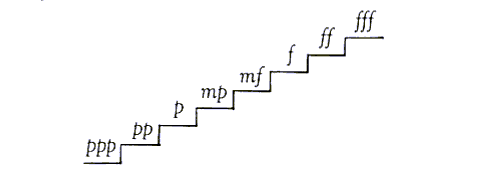
Dynamics may be thought of as a series of steps in a staircase, with the bottom step representing the softest (ppp) and the highest step the loudest (fff), which gives us eight steps, just like a scale.
Of course, there is no such thing as one specific sound level for a dynamic marking because each level is governed by the context of the music at that moment. However, once that level has been established, it is imperative to keep the integrity of the distances between that dynamic and the others in the staircase, just as intervals have precise distances. In working with various ensembles, I have sometimes experienced a pp marking that was played mf. If this is the pianissimo, I doubt that an ensemble can play loudly enough to make ff sound seven dynamic levels higher than pp.
The great composers understood this concept of dynamics completely. Anyone who studies scores cannot fail to notice the carefully crafted system of dynamic levels each composer created for a particular piece. Many people argue that all dynamics are relative and shouldn’t be taken literally; while this may occasionally be true, I believe composers expected their indications to be taken seriously. When a conductor sought Richard Strauss’ approval for some cuts that had become traditional in one of his operas, he replied, “Don’t ever ask me about cuts. If I didn’t want those passages performed, I wouldn’t have written them.”
Piano is the most abused dynamic in music today. There seems to be a world-wide transformation of the dynamic piano into something approaching mf or even f. The general attitude seems to be, “Well, it isn’t really that soft or the composer would have written pp.” Often when a performer tries to play with maximum expression, this unfortunately becomes translated into louder playing, perhaps because the performer lacks the imagination to increase expression without raising the dynamic. The basic rule of piano should be to play pp with expression, so a true pp would be almost devoid of expression but could contain various degrees of intensity, something often overlooked at soft levels. A perfect word to describe pianissimo is misterioso. For the softest level, ppp, a good definition is that the notes should be barely audible. Continuing with the middle and upper dynamics, mp should be interpreted as a projected voice in a piano environment. At mf the goal should be to play with the richest sound an instrument can produce without any trace of loudness. Moving on, f is mf with intensity, ff is a bigger and richer version of f, and fff should be the loudest sound an instrument can produce with a beautiful sound.
Another casualty in the modern world of music is atmosphere. The kind of atmosphere I refer to is the effect of pure sound at very soft levels without expression that produces a feeling of tranquility or foreboding. Composers were keenly aware of this style of writing. A wonderful example of atmosphere is the opening of Strauss’ Alpine Symphony, which depicts night and the outline of a mountain in the blackness.
Eine Alpensinfonie
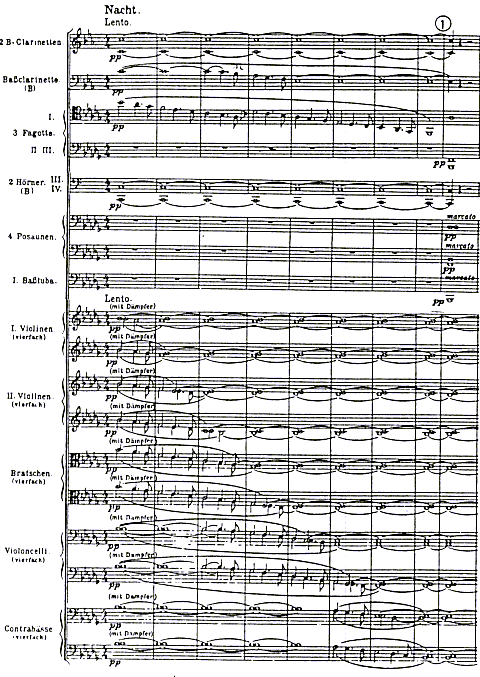
Every note of a Bb minor scale is used in a chord that produces a feeling of thick darkness. Moving voices are practically lost in the gloom, something Strauss intended. There should be no attempt to raise the dynamic to clarify voices, yet this passage has never been fully realized in modern times because of an unwillingness to produce a true pianissimo, which gives the impression of stillness, the essence of atmosphere.
If ever a composer depended on dynamics for the success of his music, it was Bruckner. In this example of atmosphere there is a dream-like tranquility, but only if the ppp is observed.
Symphony No. 4, First Movement
The orchestration is relatively unvaried and relies on dynamic contrast for cumulative momentum, as did the organ Bruckner composed on. A performance of a Bruckner symphony without scrupulous attention to soft dynamics (the loud ones are usually observed) is usually a monotonous experience, while using the full dynamic range gives musicians a large palette from which to draw. It is one of the key ingredients of style.
Another important aspect of expression is vibrato, which is used in some form on virtually every instrument. A good vibrato is one that enhances the sound and serves the phrase without calling attention to itself by being excessive: anything in excess narrows the range of expression. A common fault of singers and instrumentalists is overusing vibrato, which obscures the sound and detracts from the phrase. Also common is a vibrato that is too fast or too small for a particular instrument or voice.
Many players fall into the habit of playing with the same intensity all of the time, which narrows the range or variety of styles available to them. Great artists use a vibrato that is full and suits their instruments without sounding excessive or like an automobile trying to start with a nearly-dead battery. A great artist may push the vibrato as far as possible (because greatness involves risk taking) while keeping a perfect balance between the purity and core of the sound. A great example of this is the way violinist Jascha Heifetz used vibrato for expression and style. A vibrato should come from within the sound or become a part of it. It should enhance without obscuring the sound and never just be added like frosting on a cake.
The human ear interprets a small vibrato as a small sound and a full vibrato as a full sound. Many people produce such an incessant and inflexible vibrato that there is no center to the sound. They are unable to build a phrase and become one dimensional musicians. It would help every musician to read Leopold Auer’s words about vibrato in his book, Violin Teaching. He is vehemently opposed to anything but the sparing use of vibrato to enhance the phrase, and never to cover it.
My Dream Orchestra
My fantasy is that a wealthy benefactor would underwrite all expenses and ask me to assemble a dream orchestra, one with the best players from around the world. I could include the best European and American musicians from the Berlin, Vienna, Czech, Dresden, Leipzig, Cleveland, Chicago, Boston, and Philadelphia orchestras as well as outstanding chamber players and soloists.
The fantasy includes being able to set the schedule to include a month of training and rehearsals to give the players time to adjust to each other so the final result would be an orchestra that sounded as though it had worked together for years. To this end I would choose people who were great ensemble players and had the flexibility to adjust and blend with others. The preparatory month would begin with section rehearsals for strings, woodwinds and horns, brass, and percussion. It seems incredible to me that conductors rarely divide orchestras into smaller groups and never get beneath the surface of the ensemble. I would start with these smaller groups and establish consistent pitches using tuning principles derived from the natural overtone series with pure intervals (low major thirds, high minor thirds, expanded fifths, low major sixths and sevenths). Above all there would be a firm tonic in the bass instruments; nothing destroys ensemble intonation more than having fundamental notes of chords that are sharp, and when these are out of tune they are sharp 90% of the time.
It is up to the conductor to create an atmosphere in which intonation is openly discussed and corrected, as everyone plays out of tune at certain times. On passages that pass the bass line from instrument to instrument or section to section, it is important that the pitch of the tonic doesn’t float. Special attention should be given to matching and balancing the sound of each section, as players representing different styles and traditions adapt to others from different orchestras and traditions. It is easy to lump together players from a certain tradition as clones, but every musician is an individual, no matter how bound in the tradition they come from. Style is not that simply defined. With this super orchestra, I would strive to contradict the common occurrence that the better the orchestra, the less is asked of it.
I have seen conductors working with student ensembles or smaller professional orchestras demand excellence on many levels, but the same conductor in front of a world-class orchestra will be content with whatever the orchestra chooses to give on that occasion. Whether is the result of fear or respect, the result is not justified. Conductors often get only part of the musical potential from an ensemble that is capable of breathtaking results. Most conductors fail to realize that orchestras do not resent demands that are musically inspired; they welcome these. What they dislike are demands made for purely technical reasons, although in today’s vast wasteland of almost musicless conductors, even this is preferred to someone who is merely a timebeater.
I would strive for a string sound that is modeled on the German-Austrian tradition, sacrificing some of the American-style opulence for a sound that is weighted toward softer dynamics, less overt expression, and more blend. This means not overplaying the bow arm or left hand. Many conductors encourage, sometimes unwittingly, overusing the left hand so phrases cannot be built properly because of an intensity of expression that never rests. There can only be one culmination of each phrase, so when overexpression is the master, the phrase becomes the servant. Expression can never become the painting itself; it is only one part of the painter’s palette.
We would work on pure sound and blend with almost no left hand expression. Many years ago I had a violinist tell me that the Chicago Symphony violin section in the 1920s played the big tune in the last movement of Brahms’ First Symphony with no vibrato. Examples such as this how how subtle uses of expression will make the intense, full-bodied passages more effective through contrast.
In Strauss’s Also Sprach Zarathustra this violin passage should have a quiet, subtle expression and purity of sound to create as tranquil atmosphere. The passage comes after a tremendous climax and diminuendo of some 100 bars and is only musically effective when played this way.
Also Sprach Zarathustra

Before playing a Bruckner work, the string section should agree on certain matters of style: passages in the low register will usually be played with ample vibrato except in the softest dynamics to avoid overwhelming all other expression. In higher registers the strings should play with a faster vibrato, as in the Prelude to Lohengrin, preferably using the wrist motion that the Vienna Philharmonic violins are famous for. In the middle register, however, too much vibrato will overwhelm the sound.
Symphony No. 8, First Movement
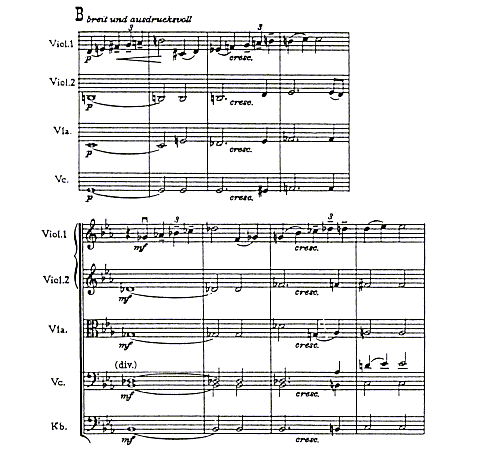
Symphony No. 5, First Movement (String Parts)
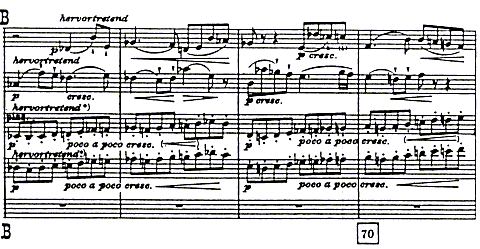
Nobody likes a dead sound, which string players are eager to demonstrate, but there is a delicate line between a dead sound and too much expression; the goal is to draw the listener into the conversation because the voices softly murmur.
This string sound is what my fantasy orchestra would use to start phrases, instead of throwing some vibrato at a phrase. Each phrase should develop from a pure origin and then return to it. This approach will give the high point of a phrase more expression because there is contrast to the way it began, which creates the illusion of a wider range of expression. The way phrases are finished has become an art form in most European orchestras, especially with the strings, and soft phrases seem to evaporate into the air.
The viola section would have only players with a true viola sound, something increasingly scarce on the orchestral scene today. A true viola sound, I believe, is neither a larger version of the violin nor that of a small cello, but is closer to the timber of the French horn. Just as the French horn should have a special mode of expression to suit its noble sound, so should the viola have a subtle form of expression that enhances its melancholy nature.
The viola writing in the following passage suggests using a simple, understated phrasing with a purity of sound and nobility of character.
Symphony No. 4, Second Movement
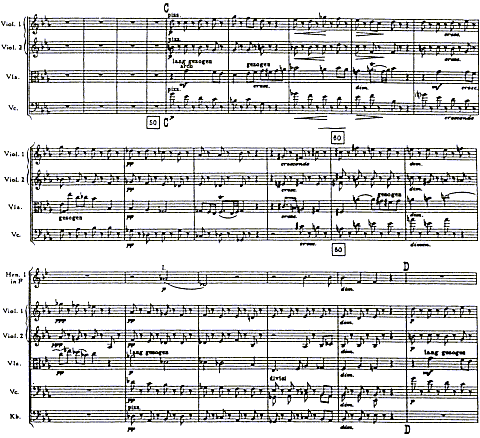
It is important that the violas not imitate the violin section and use a vibrato that obscures the character of the sound. Like four horns in unison, the golden sound of the viola should be fuller with the understated style that is a tradition with the premier European orchestras, especially on the music of Bruckner. The dynamic of mf suggests a full sound, but the marking lang gezogen (long-pulled bow) could suggest a quasi-flautando sound that is warm but somehow far away and with simple, understated expression. As with the middle register of the violin, overuse of vibrato by the violas in that register will cover the sound and the phrase. Because the range of the viola is predominantly in the orchestra’s middle register, it is especially susceptible to overexpression.
Sometimes the violas are called upon for more expression, but in this passage from Also Sprach Zarathustra the intensity should start at such a level that the crescendo and intensity rise over 28 bars to a ff climax. This means that the violas should start at approximately the same expression level as in the Bruckner example. The climax will seem to be at a higher elevation because the phrase had a modest beginning; again the steps of the staircase have kept the distances intact on both the dynamics and the expression.
Also Sprach Zarathustra
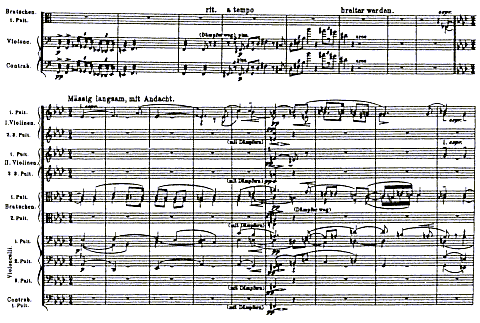
There is clearly some sacrifice of the American-style opulence for some European-style subtlety in using the musical palette. This may be a carefully created illusion because European string sections are known to have a smaller dynamic range than American counterparts, especially at the upper-end of the dynamic staircase.
The cello section of my dream orchestra would be chosen for its ensemble skills and chamber music values. Besides beauty of sound the stress would be on not overplaying melodic phrases. Like the French horn, the cello is particularly susceptible to undesirable consequences when the sound is pushed beyond its optimum resonance. Both the cello and French horn sections should strive to maintain a golden ring of sound, never going beyond the point in melodic playing where the sound has a pressed quality. Many conductors not only tolerate this, but they actually encourage it. The opening of Dvorak’s Eighth Symphony is a good example of the golden-ring-of-sound concept in cellos and horns.
Symphony No. 8, First Movement
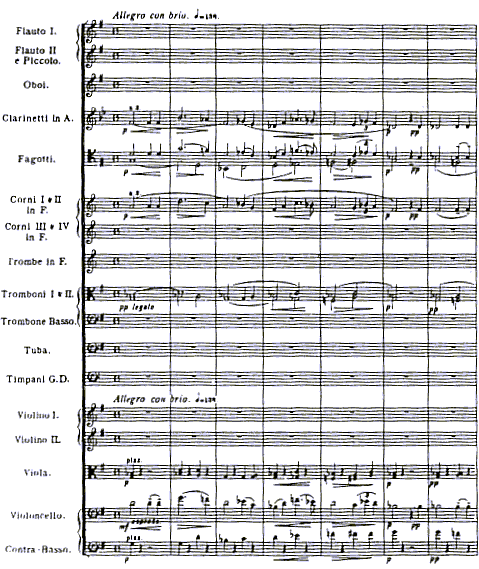
The cello dynamic is mf and the woodwind and horn dynamic is p. In the 19th century, before steel strings were used, these dynamics would have produced a good ensemble blend between the two sections, but the current tendency toward a big sound at any cost plus the power of modern strings cause the cello section to dominate completely if the woodwinds and horns play p. What is needed here is cello playing in the best Czech tradition with a rich, understated, and gentle warmth at mf without a trace of loudness.
The ideal cello and bass style provides a rich but not heavy carpet of sound. The cellos and basses are capable of remarkable lightness, as this passage from the opening of Goldmark’s Rustic Wedding Symphony demonstrates.
Rustic Wedding Symphony, First Movement

This passage can approach the lightness of the upper strings if the dynamic is strictly observed and there is no trace of heaviness. It is difficult for 20 people to resist the temptation to hear themselves above others, but that is the secret of great music making. The motto or work ethic of the entire orchestra would be the following:
When everyone tries to be heard, no one is heard; but when no one tries to be heard, everyone is heard.
The oboe, clarinet, and bassoon sections would be made up of those special players who combine the fullness and body of the German sound with the elegance and flexibility of the French tradition. The goal of the horn section is the bravura of the Vienna horns with the purity and beauty of tone of the best Czech tradition. The trumpet, trombone, and tuba group is drawn from those players who still keep the best tradition of the central European concept of sound and style alive, coupled with American-style security of execution. The increasingly popular C trumpet is replacing the instruments in various keys that composers wrote for previously. This practice works adequately some of the time, but when C trumpets replace the large trumpets in Eb and F, there are only a very few players in the world who can do this satisfactorily. What is needed is a suitable modern replacement for these instruments. The special character of these instruments is evident in these examples:
Ein Heldenleben (Brass Parts)
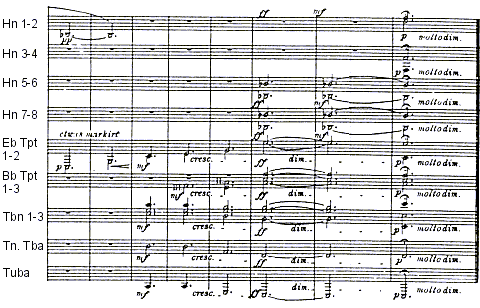
Karelia, Op. 11 (Trumpets in F)
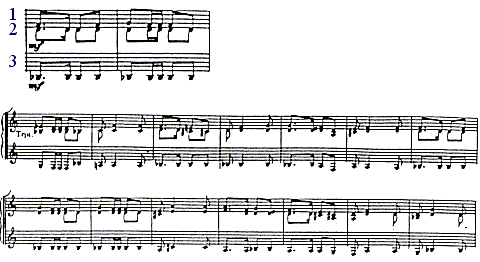
The timpani sound should be somewhere between the cello-bass and tuba; heads made with animal skins do better than synthetic heads to produce the rich, warm ambiance that blends well. The art of superior timpani playing is international in scope with enrichment of orchestral tone the most cherished attribute.
My ideal orchestra would be a sanctuary for battered musicians who have been overwhelmed by the unrelenting sound that surrounds them. The louder tutti passages have a natural place in most symphonic music, but I refer to the habit of overplaying the medium and soft dynamics. I would build a shrine to those players who have not given up their ideals and joined the fray by playing above the sound, which causes other players to escalate the dynamic to the point that everyone is covered.
The conductor should balance the sound from the softest voice downwards, not from the loudest voice upwards. Orchestra music incorporates passages for trios, quartets, and chamber ensembles within the larger group, and each entails a special balance. A piano dynamic for a full orchestra may not be the same as in a delicate trio within the same piece., but wouldn’t those soft tuttis sound wonderfully transparent if the softer end of the interpretation of a dynamic were the rule? Unfortunately the reverse is true; the trio dynamic is often determined by the full orchestra dynamic. This leads us to a distressing fact of today’s orchestral world: many of the players of instruments that are easily drowned out eventually wind up playing loudly on everything, even when playing alone.
When an orchestra rehearses, the solo playing by winds or strings should be at the same dynamic they would play at home with no other instruments around, with the orchestra’s balance adjusted accordingly. The growing trend is for soloists to play at a louder dynamic than that indicated. However, the composer carefully orchestrated the accompaniment to highlight the solo voice. The solo should be played at the dynamic indicated.
When the orchestral sound takes on a transparency, the passages that seemed over-orchestrated and unclear will create a stunning musical impression. Anyone who has studied Berlioz’s Treatise on Instrumentation knows that, contrary to popular belief, the more instruments that are playing softly the greater is the impression of softness. In other words, one hundred instruments playing softly is perceived by the ear as softer than three.
One of the most striking examples of this fact is Strauss’ pp use of the full orchestra in Death and Transfiguration.
Death and Transfiguration
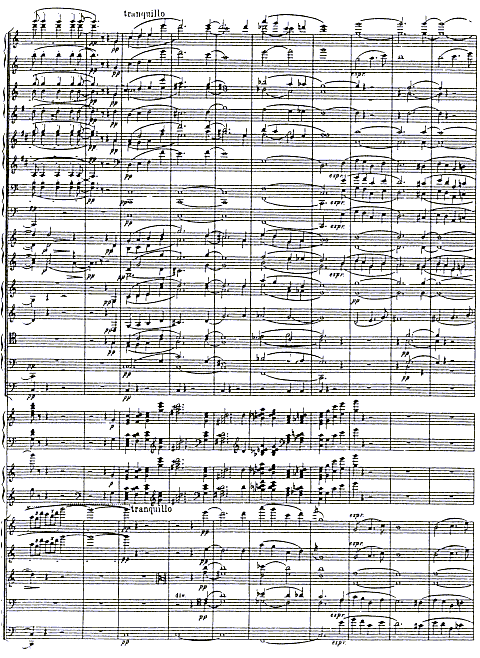
Eighty people playing absolutely pp produces a breathtaking atmosphere. Unfortunately, this is rarely achieved because of the mistaken belief that many instruments playing softly multiplies the dynamic. Untrue! However, a handful of instruments playing mf can spoil the atmosphere.
While previous examples have demonstrated pp passages at relatively slow tempos, the following example has most of the orchestra at an allegro tempo playing pp following a ff passage. When realized as Strauss imagined, a full orchestral pp at a fast tempo is even more effective than at slower speeds.
Ein Heldenleben
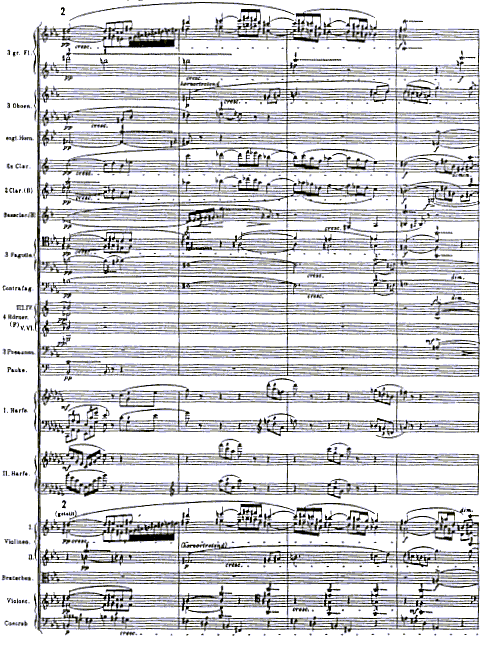
No composer in history has used the sudden change of dynamic effect more dramatically or more frequently than Beethoven. From his early works to his later period, Beethoven wrote ever more startling extremes of dynamic levels. His levels are more like plateaus than steps as a furiously raging ff drops breathtakingly to p and seconds later it returns just as suddenly to ff. It takes an orchestra and a conductor that have great discipline to realize Beethoven’s incredible dynamic scale, something that is rarely done. Regrettably, one of the few instances when conductors do work on blend is when they attempt to soften the impact of Beethoven’s abrupt dynamics by using crescendo and diminuendo to round off the corners. This makes the music conform to the current orchestral fad of not-too-soft/not-too-loud droning that robs Beethoven’s works of much of their drama.
My ideal orchestra would play the music of Dvorak to lighten the orchestral texture. As much as any 19th-century composer, Dvorak had the rare ability to make an orchestra smile or dance while expressing deep emotion at the same time. Just as a pot of plum dumplings will dance in a savory stock, Dvorak’s music is light and rich at the same time. His style is partly based on use of the agogic (bell-tone) accent, one of the most beautiful and neglected articulations in music. It is the opposite of the endless sostenuto, which has become a world-wide epidemic that drags every phrase to the bottom of the pot.
Special attention would be paid to getting maximum lift on accented notes and tutti chords, such as those in the Finale of Beethoven’s Fifth Symphony. It is the conductor’s responsibility to see that the orchestra does not play these chords in only one style. The final chords of Sibelius’ Fifth Symphony should not be played in the same style as the first notes of the Eroica Symphony or the Dies Irae of Verdi’s Requiem.
Hans Rosbaud, one of the great conductors of this century, once said that what he sought in orchestral performance was “a clear line with a beautiful sound.” The music world seems to be obsessed with lush sound at any cost; but that is only half of the equation. Rosbaud’s definition of clarity could be interpreted as an accurate sonic realization of the printed score, but the pursuit of beautiful sound is often at cross-purposes to this concept. Because sound is only a tool to serve the phrase, obsession with any one aspect, even the beauty of sound, will sacrifice some other aspect of the palette. Clarity of line, meaning the clear realization of the composer’s intent, should take precedence over all other things.
The inescapable conclusion that most contemporary musicians do not comprehend is that the length of a note has nothing to do with the clarity of its beginning. The current fashion is to deliberately obscure the beginnings of notes when playing sostenuto, which limits the extent to which a phrase can be shaped. Composers went to great lengths to indicate how phrases should be started, yet the current practice of blending together articulated passages with slurred passages produces a neither fish-nor-fowl, generic articulation that has the virtues of neither and the drawbacks of both. This mistaken practice arises for the same reason players and conductors blend p and f into a bland combination of both that produces lavish but tedious sound. The resulting “long line” is one of the most fraudulent concepts ever palmed off on the music profession. As in Ionesco’s satirical play, Rhinoceros, there is tremendous pressure to conform to the majority view that monotony is sacred and composers didn’t really know how their music should sound. Thus all those meticulously marked dynamics and phrases were meant to be thrown into a blender and emerge as a long line. One of the aims of the long line is to eliminate all the seams (silences) in the orchestral fabric, which contradicts Artur Schnabel’s famous advice to “look in the little pauses, that’s where the music resides.” Those articulated beginnings of phrases with fraction-of-a-second pauses that composers took such pains to indicate are what add tension and character to a phrase. When legato phrases are indicated the sound should be based on the human voice. A better model than a single voice is a group of voices because the legato tends to be more smoothly blended; the tasteful use of portamento should be reintroduced into modern orchestral style.
One of the most telling and beautiful effects in orchestral playing is musical ventriloquism. There are certain players around the world who can convince listeners that the sound from their instruments is coming from far away. There are many instances where composers certainly had this effect in mind, as the opening of Wagner’s Tannhauser Overture suggests the pilgrims’ solemn march and Dvorak’s use of a pianissimo solo horn in the first movement of his cello concerto. There are instances when a composer wanted a whole section to give the illusion of being removed from the scene, as in the beautiful phrase for cellos in the second movement of Mahler’s Resurrection Symphony.

Another example of a far-away atmosphere is in Pictures at an Exhibition.

The senza expression marking indicates no outward expression but suggests the picture of a Russian liturgical choir of voices softly chanting from a distant chapel. A vocal style and a distant sound make this passage magical. The key feature of this style is the masterly use of a sound that is not projected. Most conservatories teach aspiring orchestral players to project the sound above all else and the ability to play without projection has become something of a lost art, yet this is the sound most composers had in mind when they marked a passage dolce. Many players misinterpret dolce to be a license to play strongly, so everyone will hear how sweetly they play. An orchestra should avoid incessantly talking into the face of the audience.
After hearing an orchestra at a festival, George Bernard Shaw once said, “I couldn’t tell if it was a first-rate orchestra or a carefully worked up, second-rate one.” My dream orchestra would aspire to be a carefully worked up and first-rate ensemble, one with a sonic-memory of each dynamic level so the orchestra will remember how pp should sound. Nothing wastes more time than having to correct dynamic problems day after day. An orchestra cannot develop a sonic memory unless the conductor has firmly established ideas of each dynamic, but unfortunately this is not always the case. This is the conductor’s job because most orchestras are not successful at policing themselves on dynamics.
Another important responsibility of the conductor is to teach an orchestra when not to follow him. If every player intently follows the conductor, the orchestra will not play musically because each of the 100 will interpret a beat differently. The age-old question is whether it is better to be with the conductor or the ensemble, but the unequivocal answer is to be with the ensemble. Because a conductor’s beat is only a general guide, the musicians should develop a kind of ensemble awareness. American orchestras have the reputation of playing together better than their European counterparts. This may be true as far as starting and stopping phrases together is concerned; but there is a different kind of togetherness, an inner ensemble tradition that is more prevalent in Europe. This includes balance and respect for another voice as well as playing together. The goal is to combine those two qualities, but it is easier to get an ensemble to play outwardly together than to achieve inner unity. Only if the conductor perseveres on this and then relinquishes some of the ensemble responsibilities to the orchestra will this develop. After all, a symphony concert should be thought of as a recital by the orchestra, one that is rehearsed musically as well as technically. Can you imagine a recitalist practicing only passage work, leaving phrasing and other musical considerations to the spontaneity of the concert, a common occurrence in orchestral performances?
It is a rare orchestra indeed that can successfully realize the music of Ravel and Debussy. No composers have captured the essence of atmosphere more than these masters of impressionism. Unfortunately, the current fashion for hysteria in all the wrong places serves these composers very poorly. Representative of this situation is the sad decline of the French style of flute playing with an evocative, voluptuous, breathy sound and a daringly slow vibrato; at certain appropriate moments this style is without any tension whatsoever.
Those players (of any instrument) who believe the sky will fall if their intensity level drops below 100% would do well to join their vibratoless clarinet and horn colleagues to study the art of pure phrasing. An orchestra with these expanded horizons could do woundrous versions of La Mer and Daphnis and Chloe, just as a bassoon player with the voice of Chaliapin could do for the opening of the Pathetique Symphony. Conductors would better serve composers by putting their orchestra’s palettes in order and using Rubenesque colors for Beethoven and Wagner and soft, blended pastels for the impressionists.
Mahler’s belief that “the symphony must embrace the world, it must contain everything” should apply to the symphony orchestra as well as the composer. An orchestra should be capable of an enormous range of expression to perform the repertoire that was imbued by the composers with unlimited possibilities for stylistic imagination. For my dream orchestra the conductor would not have mastered all of the repertoire, only a reasonable number of pieces in which he believed deeply. His conducting technique would range in style from Furtwangler to Toscanini, using each style sensibly and imaginatively to create a moment of truth. For there exists in each great piece of music a place for almost every emotion that man is capable of expressing.
The conductor would know that phrasing, balance, and expression are as important in fortissimo as in pianissimo. He would know that a delayed, atmospheric beat is no more or less desirable than one that is crisp and strikes like lightening. He would never inhibit musicians from expressing a wide range of colors and emotions that are inspired by the composer’s intent but would insist that soft dynamics be observed, for the reason that he loves the sound of soft playing. He would avoid a bias toward one dynamic or expressive extreme. Any conductor or player who never ventures into the other end of the expressive or dynamic domain should only receive half of their regular fee. This should apply to the majority of opera singers who only sing loud and conceive of bel canto as scooping every note. Thank goodness for recital and oratorio singers.
The orchestra should resist the mob psychology that anything the majority of the ensemble does is correct when it is at odds with what the composer indicated. Many times this is mistakenly interpreted as being a tradition, but it should be labeled for exactly the bad habit that it is. Conductorless ensembles set their own standards for music making but most orchestras depend on the conductor for everything besides the correct notes.
Orchestras should make a pact with themselves to uphold musical standards, even when not asked to do so by a poor conductor. The common question is whether the conductor really makes much difference, but this is only true when he is very good. The better the conductor, the less an orchestra is on autopilot, playing not very soft or loud, not very legato or staccato, not very balanced or exciting. Unfortunately, many unimaginative conductors, who are like piano tuners, settle for an orchestra on autopilot.
The one thing common to all great performers is the mental vision of how they want to sound. The greater the performer, the higher the that vision is set. It should not be possible in a lifetime to reach a goal set high enough. Great music making results only if the conductor has a clear vision as he coordinates 90 people in an orchestra. The great conductors of the past were united in the pursuit of their vision of how a phrase could sound, and they were keenly aware that the 80-100 people in front of them were unintentionally trying to talk them out of that vision every day.
The musicians in my ideal orchestra would all be music lovers, which is not always the case. A music lover is interested in all forms of great music, whether it concerns his instrument or not. A music lover listens to colleagues no matter what the instrument, is receptive to new ideas, and is curious about traditions that are foreign to him.
Players who are fascinated by their greatness as artists should remember Schubert’s exchange with two professional musicians for whom he refused to write a new composition and who made things worse by claiming, “We are artists, just as you are. No better ones can be found in all Vienna.” Schubert retorted, “Artists! Musical hacks you are. Nothing more. One of you bites the brass stem of a wooden stick, the other blows his cheeks out on the horn. You call that art? It is a trade, a knack. I am an artist. I. I am Franz Schubert, who has written great and beautiful things that you cannot begin to understand.”
We should never cease striving to understand the musical visions of the great composers, to conduct and perform each work with the subtleties and the full palette of colors that will create a great musical picture.